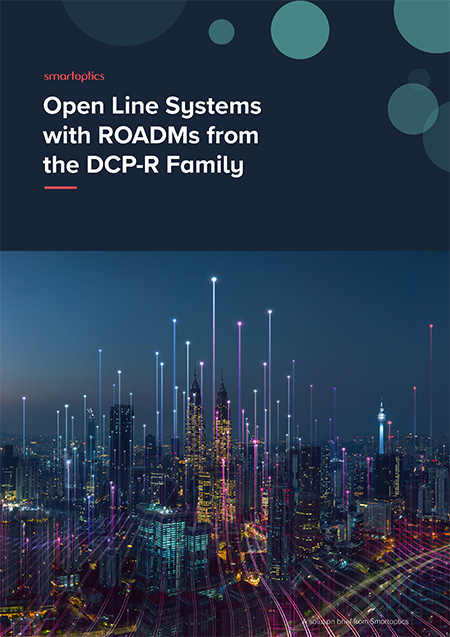HOW ROADMS PAVE THE WAY FOR TOMORROW’S FIBER OPTIC NETWORKS
We live in a world that is changing faster than ever, and that includes fiber optic network requirements. This means you will probably need to assign bandwidth and multiplex channels differently sooner or later. As a result, ROADM technologies have become increasingly popular over the past decade or so as a way to address these challenges. Discover how the next-gen, open ROADMs take this flexibility to a whole new level by combatting compatibility issues and improving cost efficiency.
What is a ROADM?
A reconfigurable optical add-drop multiplexer (ROADM) is a device that allows for multiple channels of light (DWDM) to be transmitted over a fiber pair. A ROADM can be used to add, drop pass and redirect wavelengths carrying data channels in order to customize fiber networks. For instance, certain wavelengths can be added or dropped at an intermediate point (B) between a starting point (A) and end point (C).
The distinguishing feature of ROADMs is that they can be easily remotely reconfigured to assign bandwidth and route WDM network traffic at the wavelength level. This is made possible with the Wavelength Selective Switch (WSS) technology, an active ROADM component that performs wavelength switching. Another important feature of ROADMs is their ability to monitor the optical channel power and automatically balance power between wavelengths. ROADMs are particularly useful for optimizing network traffic, meeting new bandwidth demands and improving cost efficiency.
What is a ROADM degree?
Degrees are frequently mentioned when talking about ROADMs. This refers to degrees of switching, or, in other words, the switching direction. This is related to a transmission fiber pair. For instance, a two-degree ROADM switches in two directions, a four-degree ROADM in four directions, and so on. Each direction requires another WSS element, which means that increasing the number of degrees increases the cost on a linear basis.
ROADM more flexible than OADM
ROADMs and optical add-drop multiplexers (OADMs) are both types of multiplexers. The purpose of multiplexers is to transmit multiple WDM channels over a fiber pair. Both OADM and ROADM can add, drop, pass and redirect these WDM channels to customize fiber optic networks. However, the R in the beginning of ROADMs means that they can be remotely reconfigured.
Remote reconfigurability enables ROADMs to be easily changed without having to send a technician to make physical modifications on location as with an OADM. This opens up the flexibility to set bandwidth assignment after installation and to easily reconfigure it later as needs change. ROADMs are also designed to automatically balance power levels and equalize signal loss across wavelengths while not affecting traffic already passing through the system.
The benefits of next-gen ROADM
Compared to earlier ROADM generations, the next generation we’re now starting to see several benefits driven by technological advancements. For example, FlexGrid enables the spectral width of each wavelength to be configured independently. Next-gen ROADMs can also carry more wavelengths over the same network.
Another factor is the advancement of other network components and protocols and how next-gen ROADM fits into the big picture of tomorrow’s optical networks. For instance, next-gen ROADM supports next-gen network protocols like 400 ZR and can be used together with the latest transceivers, switches and open line systems. Together, all of this is poised to significantly boost network capacity, cost effectiveness, flexibility and performance.
The Open ROADM Initiative aims to improve ROADM compatibility
The problem with proprietary ROADM architectures is that they lead to vendor lock-in. This led to the creation of the Open ROADM Multi-Source Agreement (MSA) to make next-gen ROADM more open. The collaborative initiative by industry leaders aims to jointly develop and implement ROADM interoperability specifications.
Service providers stand to benefit from the initiative in many ways. One is that moving toward open standardized interfaces and interoperability will empower them to always choose the best components for their use case. This is aligned with the Open ROADM project’s goal to accelerate innovation and competition as well as to drive mass adoption of next-gen ROADM.
However, combining ROADM and other network components from different vendors without a common management system is another problem. It adds unnecessary complexity and inefficiencies when you can’t easily perform fault and configuration management for the whole network from a single interface. To solve this, the initiative is also paving the way for common, open management systems. These hold great potential for enabling smart management of disaggregated networks to improve ROADM flexibility and optimization.
The role of Smartoptics in driving open networking
Not only are we committed to supporting open networking but we put our money where our mouth is by ensuring our latest fiber optic networking products are as interoperable and flexible as possible. We don’t see the need to force you to use all components surrounding ROADM from us.
With its open architecture and support for multiple traffic formats, the Smartoptics DCP-R Family allows you to implement virtually any type of ROADM-based network topology, disintegrating the once monolithic optical platforms into separate, open line systems, switches with embedded transceivers and transponders.

Get the guide to OLS with ROADMs from the DCP-R Family
Download our solution brief to learn more about the latest ROADM opportunities.

Get the guide to OLS with ROADMs from the DCP-R Family
Download our solution brief to learn more about the latest ROADM opportunities.
Related articles

What is a SAN and how does it protect mission-critical workloads?

What is Fibre Channel used for?
